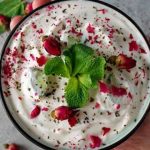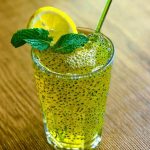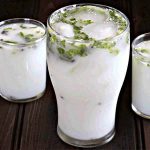
Persian Food and Drinks List
Persian Food and Drinks Guide
Food can represent the rich customs and traditions of a nation, and eating a delicious local meal can create a sweet memory for the tourists. Thus, most people are interested in trying traditional dishes when they travel to a new destination. If you belong to this group, and even if you don’t, visiting Iran brings you a variety of traditional Persian food as well as a sweet memory.
Iran’s long history, the crossing Silk Road and Spice trade routes, and access to open waters have made a great variety in Iran foods and drinks. On the other hand, the diverse geography and climate of different Iran destinations have shaped various Iranian cuisines and ingredients. In other words, Iran foods and drinks reflect the history, culture, tradition, and lifestyle of the Iranians.
During your Iran trip, you will notice that food is very important to Iranians. As a result, the Persian table is always colorful and full of different foods and drinks. Moreover, Iranians prefer to eat their meals with the whole family at a determined time. And, despite the entanglement in modern life, this valuable tradition still stands.
There’s a vast spectrum of famous Persian dishes; Juicy stews with slices of meat, juicy barbecues with saffron, sweets filled with delicious creams are among the most famous Persian dishes. Along with food, there are different Persian drinks, including warm and cold beverages. In this regard, the typical Persian cold drink is Dugh, while the traditional warm drink is black tea.
Since as a tourist you stay in Iran for the short term, you should know the famous Persian dishes of each city to get the most out of your Iran trip. So, we have prepared a list of the most famous Iran foods and drinks you should try when visiting Iran.
Kabab (Persian Kebab)
Kebab (barbecued meat) is one of the famous Persian dishes in Iran and outside of Iran’s borders. Notably, this delicious Iranian food originally came from the Caucasus during the Qajar period, and the Persian chefs changed its cooking style. Therefore, today’s Persian Kebab is known as entirely Iranian food.
There are diverse Iranian kebab types mostly served with rice (Chelow or Kateh) in Iran. So, the famous “Chelow Kabab” is the best Persian food consisting of rice and Kebab. In addition to rice, the Kebab’s side dish is fresh basil, lemons, barbecued tomato, and a traditional Persian drink called Dough (yogurt drink). Here are the most famous Persian Kebabs.
Ingredients: A kind of meat (based on Kebab’s type), Onion, Black pepper, Sumac, Fresh lemon, Yogurt, or Saffron (based on Kebab’s type)
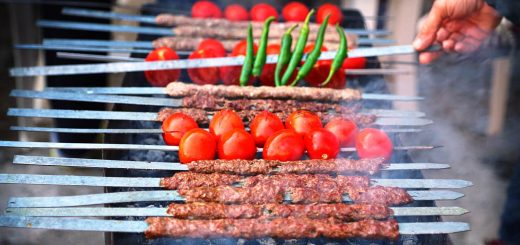
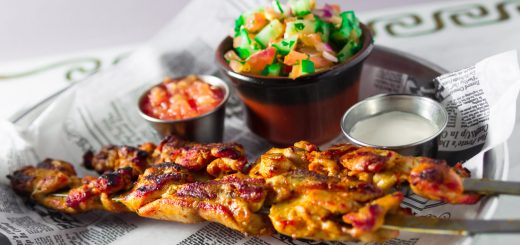
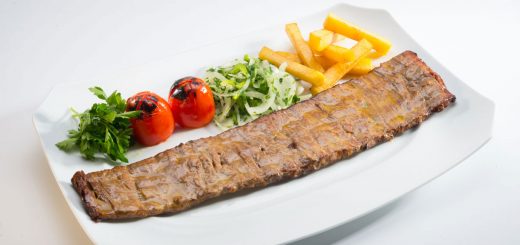

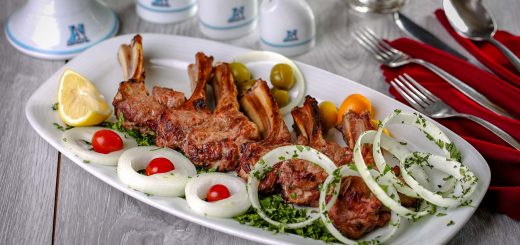
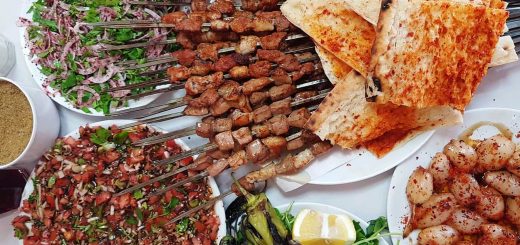
Persian Kabab Menu
* The prices are rough and based on a qualified dish served in a popular traditional restaurant in major cities. Usually, the prices are a little lower in casual dining restaurants and in small towns.
-
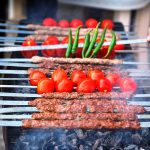 Kabab Koobideh $4
Kabab Koobideh $4ground lamb or beef, onion, black pepper, sumac, fresh lemon
-
 Joojeh Kabab (arbecued chicken) $4
Joojeh Kabab (arbecued chicken) $4sliced chicken, onion, black pepper, fresh lemon, saffron, butter, yogurt (optional)
-
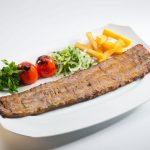 Kabab Barg $6
Kabab Barg $6sliced lamb or beef, onion, black pepper, fresh lemon, butter, saffron
-
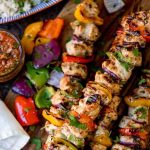 Lari Kebab (Kabab Lari) $5
Lari Kebab (Kabab Lari) $5sliced meat (chicken, lamb or beef), onion, black pepper, fresh lemon, yogurt (optional), butter
-
 Shishlik (Shashlik) $11
Shishlik (Shashlik) $11sheep's ribs, onion, black pepper, fresh lemon, butter, saffron
-
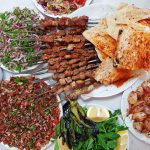 Jigar Kabab (Grilled Liver Kebab) $2
Jigar Kabab (Grilled Liver Kebab) $2lamb liver, onion, black pepper, fresh lemon
Khoresht (Khoresh)
The Persian word “Khoresht” or “Khoresh” means a kind of stew that is mostly served with rice that is called “Chelo Khoresh.” There are numerous Persian stews, which mostly contain a kind of meat. However, you can omit the meat from the Khoresh dish and prepare a vegetarian-friendly traditional Persian food. Besides, different types of Khoresht are prepared with diverse cooking methods all over Iran with local herbs and spices. Here are the most popular Persian Khoresht dishes with their ingredients.
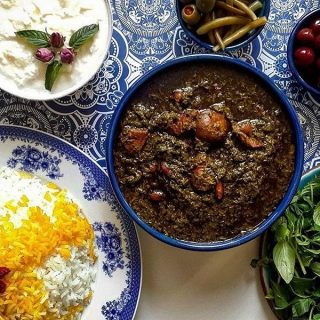
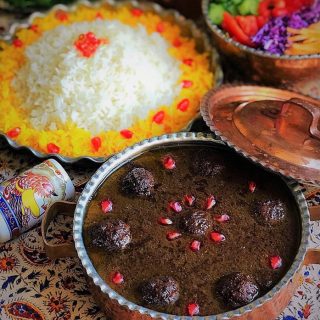
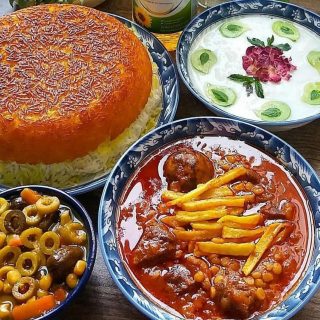
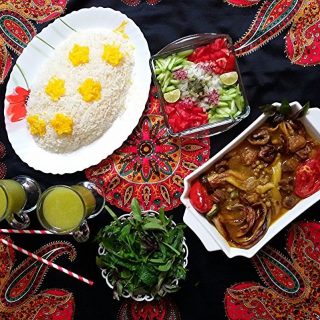
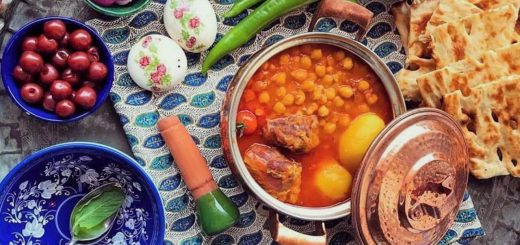
Khoresht Menu
* The prices are rough and based on a qualified dish served in a popular traditional restaurant in major cities. Usually, the prices are a little lower in casual dining restaurants and in small towns.
-
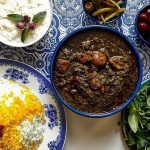 Khoresht-e Ghormeh Sabzi (Ghormeh Sabzi Stew) $3
Khoresht-e Ghormeh Sabzi (Ghormeh Sabzi Stew) $3sliced lamb or beef meat, onion, dried red or black-eye beans, turmeric, Persian dried limes, fresh vegetables (garlic, fenugreek, cilantro, parsley, spinach, chives), other local green vegetables or herbs
-
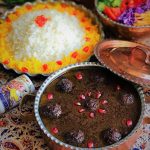 Khoresht-e Fesenjan (Fesenjan Stew) $4
Khoresht-e Fesenjan (Fesenjan Stew) $4chicken or duck meat, onion, ground walnuts, pomegranate juice or paste, cardamom, cinnamon or saffron (optional), sugar (optional)
-
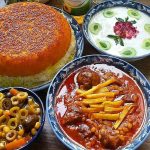 Khoresht Gheymeh (Gheymeh Stew) $3
Khoresht Gheymeh (Gheymeh Stew) $3Mutton, Split Peas, Onion, Tomato or Tomato Paste, Potato, Saffron, Turmeric, Cinnamon (Optional)
-
 Khoresh Bademjan (Persian Eggplant Stew) $3
Khoresh Bademjan (Persian Eggplant Stew) $3Mutton, Eggplant, Onion, Tomato or Tomato Paste, Turmeric, Abghooreh (Verjuice) or Ghooreh (Sour Grapes), Saffron (Optional)
-
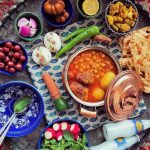 Dizi (Abgoosht) $4
Dizi (Abgoosht) $4Mutton, Potato, Onion, Tomato or Tomato Paste, Beans, Chickpeas, Turmeric
Polo (Polow)
Generally, you can find rice in most Iranian cuisines. Iranians cook rice in different styles, and the most popular ones are Chelo and Polow. To cook “Chelo” or ”Chelow” the Iranians first boil the white rice with salt and oil and then brew it. On the other hand, The Persian word “Polo” or “Polow” means steamed rice mixed and cooked with other ingredients. Usually, these ingredients are herbs, meats, legumes, or different kinds of vegetables.
Numerous types of traditional Persian food have rice in their recipes, such as Zeresk Polo, Loobia Polo, Adas Polo, Baghali Polo, etc. However, you can omit the meat from Polo and prepare a vegetarian-friendly Iranian food. Also, the inhabitants of different Iran cities cook numerous Polow types with diverse cooking methods using their local herbs and spices. Here are the most famous Persian Polow dishes with their ingredients.
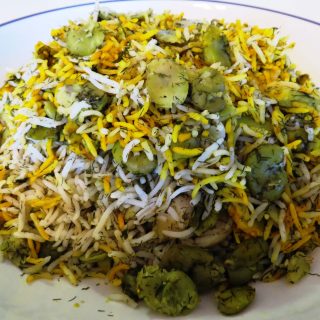
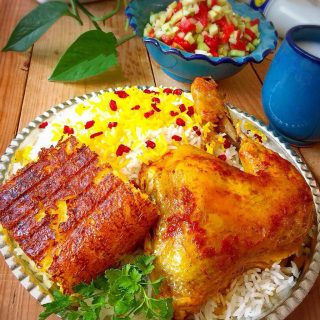

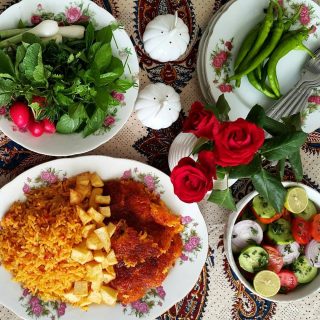
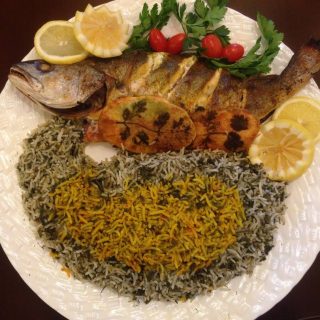
Read more about: Nowruz Celebration
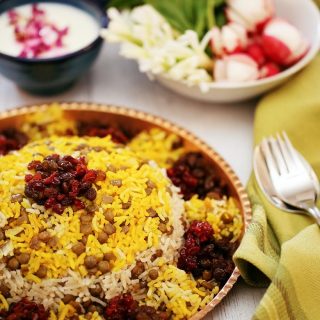
Polo Menu
* The prices are rough and based on a qualified dish served in a popular traditional restaurant in major cities. Usually, the prices are a little lower in casual dining restaurants and in small towns.
-
 Baghali Polo (Persian Rice with Fava Beans and Dill) $2
Baghali Polo (Persian Rice with Fava Beans and Dill) $2Rice, Fava Beans, Dill, Saffron
-
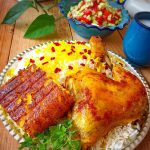 Zereshk Polo ba Morgh (Barberry Rice with Chicken) $3
Zereshk Polo ba Morgh (Barberry Rice with Chicken) $3Rice, Chicken, Tomato Paste, Barberry, Lime Juice, Saffron, Onion, Sliced Almonds, Sliced Pistachios, Turmeric, Black Pepper
-
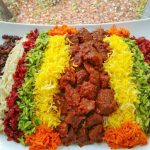 Morasa Polo (Persian Jewelled Rice) $4
Morasa Polo (Persian Jewelled Rice) $4Rice, Saffron, Onion, Crushed Pistachio, Crushed Almond, Orange’s Peel, Barberry, Raisins, Chicken, Sugar, Cardamom (optional)
-
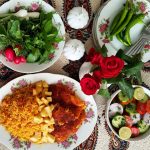 Estamboli polo (Persian tomato rice) $2
Estamboli polo (Persian tomato rice) $2Rice, Tomato, Potato, Onion, Turmeric
-
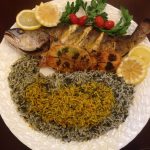 Sabzi Polo Mahi (Sabzi Polo Ba Mahi) $5
Sabzi Polo Mahi (Sabzi Polo Ba Mahi) $5Rice, Fish, Herbs (Dill, Parsley, Leek, and Coriander), Saffron, Spices
-
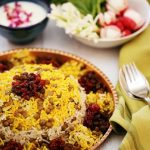 Adas Polo (Persian Rice with Lentils) $3
Adas Polo (Persian Rice with Lentils) $3Rice, Lentils, Onions, Raisins
Persian Soup (Ash)
Iranians are professional in making diverse kinds of soups. Also, the inhabitants of different cities in Iran different cook numerous types of soups with various cooking methods using local herbs and spices. The Persian word “Ash” includes all kinds of soups that mostly are thick and full of ingredients. Usually, these ingredients are herbs, meats, legumes and rice or a type of grain.
There are numerous “Ash” in Iranian cuisine, such as Ash Reshteh, Barley Soup, and Ash Doogh (Yogurt Soup), etc. On the other hand, the Iranians are used to prepare numerous kinds of Haleem and porridges. Here we present the most famous Iranian soups with their ingredients.
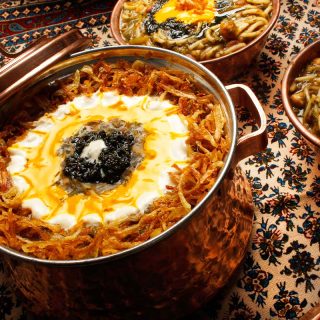
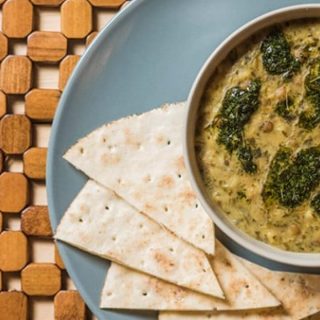
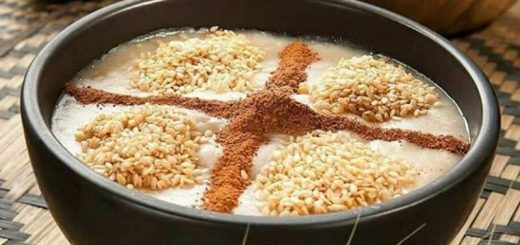
Persian Soup Menu
* The prices are rough and based on a qualified dish served in a popular traditional restaurant in major cities. Usually, the prices are a little lower in casual dining restaurants and in small towns.
-
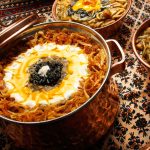 Ash Reshteh (Persian Noodle Soup) $2
Ash Reshteh (Persian Noodle Soup) $2Persian Noodle, Legumes (Beans, Chickpeas, Lentils), Leek, Parsley, Coriander, Spinach, Kashk (Curd), Onion, Mint, Garlic
-
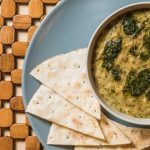 Persian Barley Soup (Ash-e Jo) $2
Persian Barley Soup (Ash-e Jo) $2Barley, Chickpeas, Beans, Meat, Onions, Garlic, Mint, Leek, Parsley, Coriander, Curd (Kashk)
-
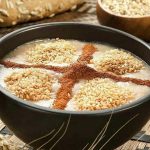 Halim Gandom (Wheat Porridge) $2
Halim Gandom (Wheat Porridge) $2Mutton, Wheat, Onion, Cinnamon, Sugar
Iranian Side Dish (Iranian Appetizer)
In the Iranian houses, it is common to serve the appetizer as the side dish accompanying the main dish. Hence, it is not easy to draw a line between Persian appetizers, and side dishes in Iranian cuisine. However, in the restaurant, their difference is more defined on the menu. By the way, the most common Iranian side dishes are yoghurt mixed with other ingredients, salads and assorted pickles. Besides, some light meals and soups are between the Iranian appetizers.
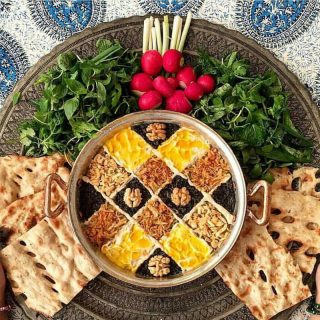
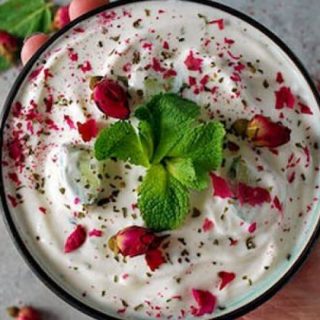
Iranian Side Dish Menu
* The prices are rough and based on a qualified dish served in a popular traditional restaurant in major cities. Usually, the prices are a little lower in casual dining restaurants and in small towns.
Iranian Drinks and Beverages
If you travel to Iran either in the hot summer or cold winter, you will find a suitable Persian drink. Accordingly, Iranian drinks and beverages are divided into cold refreshing summer drinks, including Sharbat, Aragh, Doogh, etc., and hot beverages such as Dam Noosh (Persian herbal tea). Usually, Iranian beverages consist of herbal extracts and are good for your health.
Here, we introduce some of the best Iranian drinks and beverages you should not miss to try on your Iran trip.
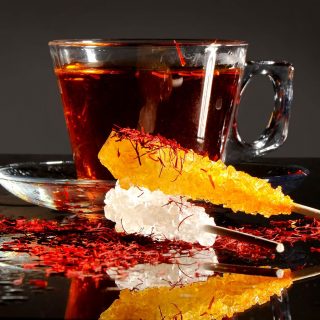
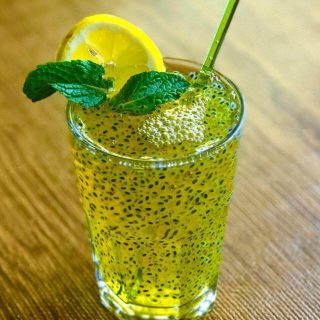
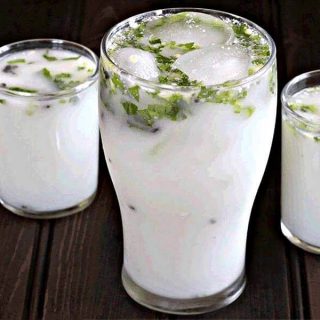
Iranian Drinks and Beverages Menu
* The prices are rough and based on a qualified dish served in a popular traditional restaurant in major cities. Usually, the prices are a little lower in casual dining restaurants and in small towns.
Persian Dessert
When you visit Iran as a foreign tourist, usually, the first thing you see on the restaurant menu is diverse kinds of kebab. But, what you should not miss when traveling to Iran are the unique Persian desserts that tourists usually like. Different kinds of Persian halva, porridges, and Persian sweets are among the best Iranian desserts. Notably, traditional Persian desserts are very sweet, and many of them contain rosewater and saffron. Below is a list of the most famous Iranian desserts that you should definitely try on your Iran trip.
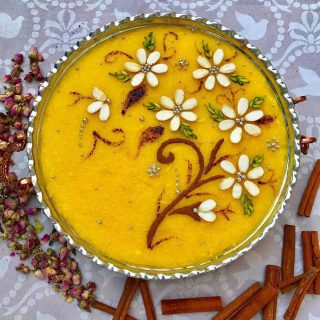
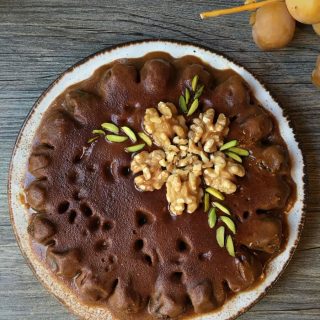
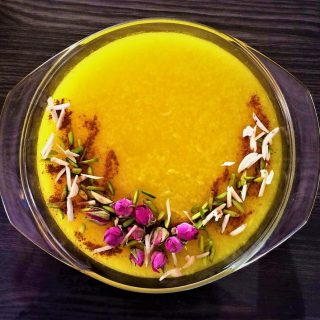

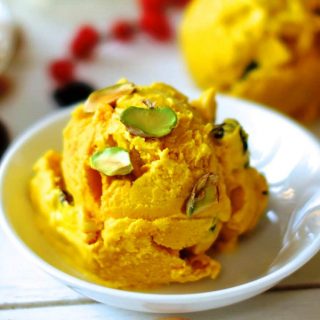
Persian Dessert Menu
* The prices are rough and based on a qualified dish served in a popular traditional restaurant in major cities. Usually, the prices are a little lower in casual dining restaurants and in small towns.
-
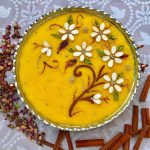 Halva $2
Halva $2Flour, Sugar, Oil or Butter, Rosewater, Saffron, Cardamom, Nuts, etc.
-
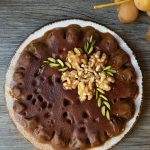 Ranginak $2
Ranginak $2Date, Walnut, Oil, Butter, Cinnamon, Powdered Sugar
-
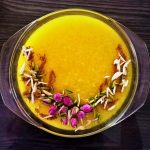 Sholeh Zard (Persian Saffron Rice Pudding) $2
Sholeh Zard (Persian Saffron Rice Pudding) $2Rice, Saffron, Sugar, Sliced Almond, Rosewater, Cinnamon, Butter
-
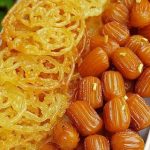 Zoolbia Bamieh $3
Zoolbia Bamieh $3Starch, Yogurt, Oil, Saffron, Rosewater, Sugar, Egg, Flour, Lemon Juice
-
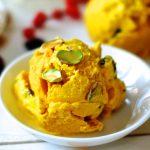 Traditional Persian ice cream (Bastani sonnati) $2
Traditional Persian ice cream (Bastani sonnati) $2Milk, Salep, Cream, Saffron, Rosewater, Sugar, Sliced Pistachio



